|
Hummingbird |
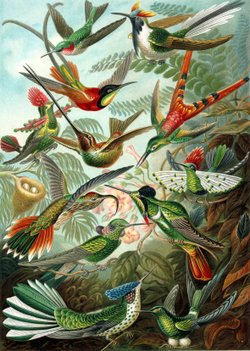
A variety of hummingbirds from
Ernst Haeckel's 1904 Kunstformen der Natur (Artforms of
Nature)
|
|
Scientific classification |
| Kingdom: |
Animalia
|
| Phylum: |
Chordata
|
| Class: |
Aves
|
| Order: |
Apodiformes
|
| Family: |
Trochilidae
Vigors, 1825 |
|
| Subfamilies |
Phaethornithinae
Trochilinae |
Hummingbirds are small
birds in the
family Trochilidae. They are known for their
ability to hover in mid-air by rapidly flapping their
wings, 15 to 80 times per second (depending on the
species). Capable of sustained hovering, the hummingbird has
the ability to fly deliberately backwards or vertically, and
to maintain position while drinking from flower blossoms.
They are named for the characteristic
hum
made by their wings.
Hummingbirds are attracted to many flowering
plants—shrimp plants, Heliconia, bromeliads, verbenas,
fuchsias, many penstemons—especially those with red flowers.
They feed on the nectar of these plants and are important
pollinators, especially of deep-throated flowers. Most
species of hummingbird also take insects, especially when feeding young.
The
Bee Hummingbird (Mellisuga helenae) is the smallest bird in
the world, weighing 1.8 grams. A more typical hummingbird, such as the Rufous
Hummingbird (Selasphorus rufus), weighs approximately
3 g and has a length of 10-12 cm (3.5-4 inches). The largest
hummingbird is the Giant Hummingbird (Patagona gigas),
with some individuals weighing as much as 24 grams.
Most male hummingbirds take no part in nesting. Most
species make a neatly woven cup in a tree branch. Two white
eggs are laid, which despite being the smallest of all bird
eggs, are in fact large relative to the hummingbird's adult
size.
Incubation is typically 14-19 days.
Appearance
Hummingbirds bear the most glittering
plumage and some of the most elegant adornments in the
bird world. Male hummingbirds are usually brightly coloured.
The females of most species are duller.
The names that admiring naturalists have given to
hummingbirds suggest exquisite, fairylike grace and gemlike
brilliance. Fiery-tailed Awlbill, Ruby-topaz Hummingbird,
Glittering-bellied Emerald, Brazilian Ruby, Green-crowned
Brilliant, Festive Coquette, Shining Sunbeam, and
Amethyst-throated Sunangel are some of the names applied
to birds in this group.
Aerodynamics of hummingbird flight
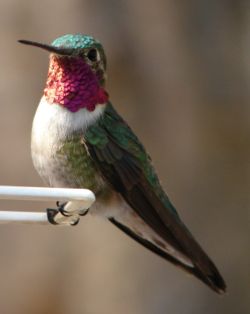
A male
Ruby-throated Hummingbird
Hummingbird flight has been studied intensively from an
aerodynamic perspective: Hovering hummingbirds may be filmed
using high-speed video cameras.
Writing in Nature, biophysicist Douglas Warrick and
coworkers studied the Rufous Hummingbird, Selasphorus rufus,
in a wind tunnel using particle image velocimetry techniques and investigated
the lift generated on the bird's upstroke and downstroke.
They concluded that their subjects produced 75% of their
weight support during the downstroke and 25% during the
upstroke: many earlier studies had assumed (implicitly or
explicitly) that lift was generated equally during the two
phases of the wingbeat cycle. This finding shows that
hummingbirds' hovering is similar to, but distinct from,
that of hovering insects such as the hawk moths. The differences result from an inherently
dissimilar avian body plan (Warrick et al., 2005).
Metabolism
With the exception of insects, hummingbirds while in
flight have the highest metabolism of all animals, a
necessity in order to support the rapid beating of their
wings. Their heartbeat can reach as high as 1260 beats per
minute, a rate once measured in a Blue-throated hummingbird
[1]. They also typically consume more than their own weight
in food each day, and to do that they have to visit hundreds
of flowers daily. At any given moment, they are only hours
away from starving. However, they are capable of slowing
down their metabolism at night, or any other time food is
not readily available. They enter a hibernation-like state
known as torpor. During torpor, the heartrate and rate of
breathing are both slowed dramatically (the heartrate to
roughly 50-180 beats per minute), reducing their need for
food.
Studies of hummingbirds' metabolism are highly relevant
to the question of whether a
migrating
Ruby-throated Hummingbird can cross 800 km (500 miles) of
the Gulf of Mexico on a nonstop flight, as field
observations suggest it does. This hummingbird, like other
birds preparing to migrate, stores up fat to serve as fuel,
thereby augmenting its weight by as much as 40 to 50 percent
and hence increasing the bird's potential flying time.
(Skutch, 1973)
Range
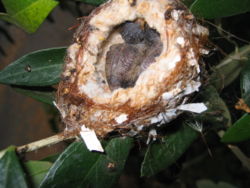
Hummingbird nest with two chicks in Santa
Monica, CA
Hummingbirds are found only in the Americas, from
southern Alaska and Canada to Tierra del Fuego, including
the West Indies. The majority of species occur in tropical
Central and South America, but several species also breed in
temperate areas. Excluding vagrants, sometimes from Cuba or
the Bahamas, only the migratory Ruby-throated Hummingbird
breeds in eastern North America. The Black-chinned
Hummingbird, its close relative and another migrant, is the
most widespread and common species in the western United
States and Canada.
Most hummingbirds of the U.S. and Canada and southern
migrate to warmer climates in the northern winter, though
some remain in the warmest coastal regions. Some southern
South American forms also move to the tropics.
The Rufous Hummingbird shows an increasing trend to
migrate east to winter in the eastern United States, rather
than south to Central America, as a result of increasing
survival prospects provided by artificial feeders in
gardens. In the past, individuals that migrated east would
usually die, but now many survive, and their changed
migration direction is inherited by their offspring.
Provided sufficient food and shelter is available, they are
surprisingly hardy, able to tolerate temperatures down to at
least -20°C.
Systematics and evolution
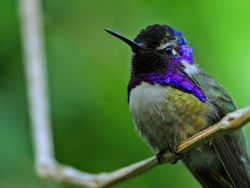
A male
Costa's Hummingbird, showing its plumage to
good effect
Traditionally, hummingbirds were placed in the order
Apodiformes, which also contains the
swifts. In the
Sibley-Ahlquist taxonomy, hummingbirds are separated as
a new order, Trochiliformes, but this is not well supported
by additional evidence.
There are between 325 and 340 species of hummingbird,
depending on taxonomic viewpoint, divided into two
subfamilies, the
hermits (subfamily Phaethornithinae, 34
species in six genera), and the typical hummingbirds
(subfamily Trochilinae, all the others). This
arrangement has been extensively verified (see review in
Gerwin & Zink, 1998).
The modern diversity of hummingbirds is thought by
evolutionary biologists to have evolved in South America, as
the great majority of the species are found there. All of
the most common North American species are thought to be of
relatively recent origin, and are therefore (following the
usual procedure of lists starting with more 'ancestral'
species and ending with the most recent) listed close to the
end of the list. However, as seen below, the actual origin
of the hummingbird lineage now seems to have been parts of
Europe to what is southern
Russia today.
Genetic analysis has indicated that the hummingbird
lineage diverged from their closest relatives some 35
million years ago, in the Late
Eocene, but fossil evidence has proved quite elusive. Fossil
hummingbirds are known from the Pleistocene of Brazil and
the Bahamas - neither of which has been scientifically
described -, and there are fossils and subfossils of a few
extant species known, but until recently, older fossils had
not been securely identifiable as hummingbirds.
Then, in
2004, Dr. Gerald Mayr of the Senckenberg Museum in Frankfurt
am Main identified two 30-million-year-old hummingbird
fossils and published his results in Nature. The fossils of
this primitive hummingbird species, named Eurotrochilus
inexpectatus ("unexpected European hummingbird"), had been
sitting in a museum drawer in Stuttgart; they had been
unearthed in a clay pit at Wiesloch-Frauenweiler, south of
Heidelberg, Germany and because it was assumed that hummingbirds
never occurred outside the Americas were never believed to
be hummingbirds until Mayr took a closer look at them.
Fossils of birds not clearly assignable to either
hummingbirds or a related, extinct family, the
Jungornithidae, have been found at the Messel pit and in the
Caucasus, dating from 40-35 mya, proving that the split
between these two lineages indeed occurred at that date. The
areas where these early fossils have been found had a
climate quite similar to the northern Caribbean or
southernmost China during that time. The biggest remaining
mystery at the present time is what happened to hummingbirds
in the roughly 25 million years between the primitive
Eurotrochilus and the modern fossils. The astounding
morphological adaptations, the decrease in size and the
dispersal to the Americas and extinction in Eurasia all
occurred during in this timespan. DNA-DNA hybridization
results (Bleiweiss et al, 1994) suggest that the main
radiation of South American hummingbirds at least partly
took place in the Miocene, some 12-13 mya, durng the uplifting of the
northern
Andes.
Hummingbirds and humans
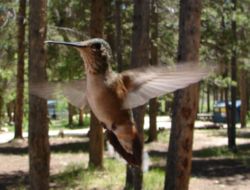
A female Ruby-throated Hummingbird in flight;
note the speed of the wingbeats
Hummingbirds sometimes fly into
garages and become trapped. It is widely believed that this
is because they mistake the hanging (usually red-color)
door-release handle for a flower, although hummingbirds can
also get trapped in enclosures that do not contain anything
red. Once inside, they may be unable to escape because their
natural instinct when threatened or trapped is to fly upward.
This is a life-threatening situation for hummingbirds, as
they can become exhausted and die in a relatively short
period of time, possibly as little as an hour. If a trapped
hummingbird is within reach, it can often be caught gently
and released outdoors. It will lie quietly in the space
between cupped hands until released.
Hummingbird feeders and nectar
The diet of hummingbirds requires an energy source
(typically
nectar) and a protein source (typically small insects). For
nectar, hummingbirds will happily take artificial nectar
from man-made feeders. Such feeders allow people to observe
and enjoy hummingbirds up-close while providing the
hummingbirds with a reliable supply of nectar, especially
when flower blossoms are less abundant.The feeders can be
placed as high as 60 meters maximum. Homemade nectar can be
made from 1 part white, granulated table sugar to
4 parts water, boiled to make it easier to dissolve the
sugar and to purify the solution so that it will stay fresh
longer. The cooled nectar is then poured into the feeder.
Honey should not be used because it is prone to culture a
bacterium that is dangerous to hummingbirds.[1]
Diet sweeteners should also be avoided because, though the
hummingbirds will drink it, they will be starved of the
calories they need to sustain their metabolism.
Some commercial hummingbird foods contain red dyes and
preservatives which are unnecessary and have not been
studied for long-term effects on hummingbirds. While it is
true that bright colors (especially red) attract
hummingbirds, it is better to use a feeder that has some red
on it, rather than coloring the water. There are suggestions
that red dye is harmful to hummingbirds
[2] . Yellow dyes also cannot be used, as it has
been known to attract bees and wasps. Commercial nectar
mixes may contain small amounts of mineral nutrients which
are useful to hummingbirds, but hummingbirds get all
the nutrients they need from the insects they eat, not from
nectar, so the added nutrients are also unnecessary.
Authorities on hummingbirds recommend just plain sugar and
water (Shackelford et al., 2005).
A hummingbird feeder should be easy to refill and clean.
Prepared nectar can be refrigerated for 1 to 2 weeks before
being used, but once placed outdoors it will only remain
fresh for 2-4 days in hot weather or 4-6 days in moderate
weather before turning cloudy or developing mold.
Hummingbirds can be seriously harmed if they sip from a
feeder with nectar that has gone bad. When changing the
nectar, the feeder should be rinsed thoroughly with warm tap
water, flushing the reservoir and ports to remove any
contamination or sugar build-up. If dish soap is used, it
needs extra rinsing so that no residue is left behind. The
feeder can be soaked in dilute chlorine bleach if black
specks of mold appear.
Other animals are also attracted to hummingbird feeders.
It is a good idea to get a feeder that has very narrow
ports, or ports with mesh-like "wasp guards", to prevent
bees and wasps from getting inside where they get trapped.
Orioles are known to drink from hummingbird feeders,
sometimes tipping them and draining the liquid. If this
becomes a problem, it is possible to buy feeders which are
specifically designed to support their extra weight and
which hummingbirds will use too. If ants find your
hummingbird feeder, one solution is to install an "ant
moat", which is available at specialty garden stores and
online.
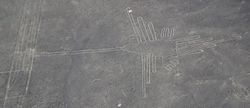
Hummingbird image at Nazca
Hummingbirds in myth and culture
- The Aztec god Huitzilopochtli is often depicted as a
hummingbird.
One of the Nazca Lines depicts a hummingbird.
The Ohlone tells the story of how a Hummingbird brought
fire to the world. See an article at the National Parks
Conservation Association's website for a recounting.
Trinidad and Tobago is known as "The land of the
hummingbird," and a hummingbird can be seen on that
nation's 1 cent coin.
Many popular songs have been written under the title
"Hummingbird", including separate works by B.B. King,
Wilco, Leon Russell, John Mayer, Frankie Laine, Cat
Stevens, Seals and Crofts, Merzbow and Yuki.
References
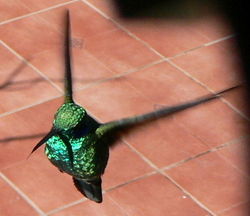
Male
Green Violet-ear in flight
- Bleiweiss, Robert; Kirsch, John A. W. &
Matheus, Juan Carlos (1999): DNA-DNA hybridization
evidence for subfamily structure among hummingbirds.
Auk 111(1): 8-19.
PDF fulltext
- del Hoyo, J.; Elliott, A. & Sargatal, J.
(editors) (1999):
Handbook of Birds of the World, Volume 5: Barn-owls
to Hummingbirds. Lynx Edicions, Barcelona.
ISBN 84-87334-25-3
- Gerwin, John A. & Zink, Robert M.
(1998): Phylogenetic patterns in the Trochilidae.
Auk 115(1): 105-118.
PDF fulltext
- Meyer de Schauensee, Rodolphe (1970): A
Guide to Birds of South America. Livingston,
Wynnewood, PA.
- Shackelford, Clifford Eugene; Lindsay, Madge
M. & Klym, C. Mark (2005): Hummingbirds of Texas with
their New Mexico and Arizona ranges. Texas A&M
University Press, College Station.
ISBN 1-58544-433-2
- Skutch, Alexander F. & Singer, Arthur
B. (1973): The Life of the Hummingbird. Crown
Publishers, New York.
ISBN 0-517-50572X
- Warrick, D. R.; Tobalske, B.W. & Powers, D.R.
(2005): Aerodynamics of the hovering hummingbird.
Nature 435: 1094-1097
DOI:10.1038/nature03647
(HTML abstract)
Footnotes
- ^
http://faq.gardenweb.com/faq/lists/hummingbird/2003021845028716.html
- ^
http://www.hummingbirds.net/dye.html
External links
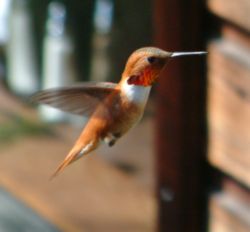
A
Rufous Hummingbird hovering in flight at Hells
Gate, British Columbia




